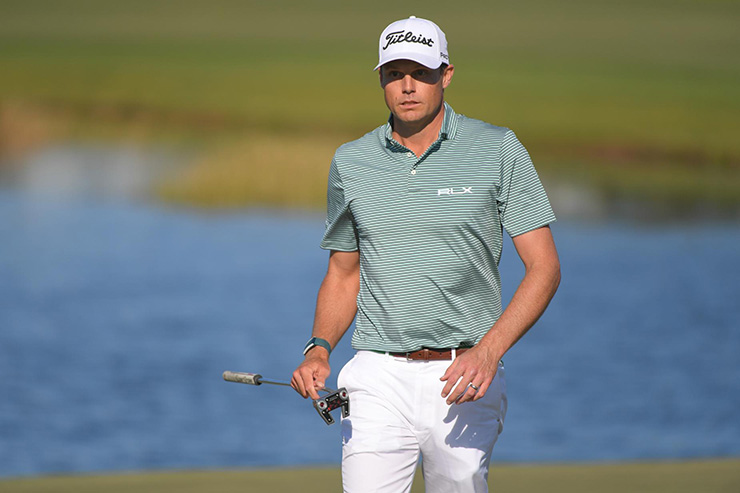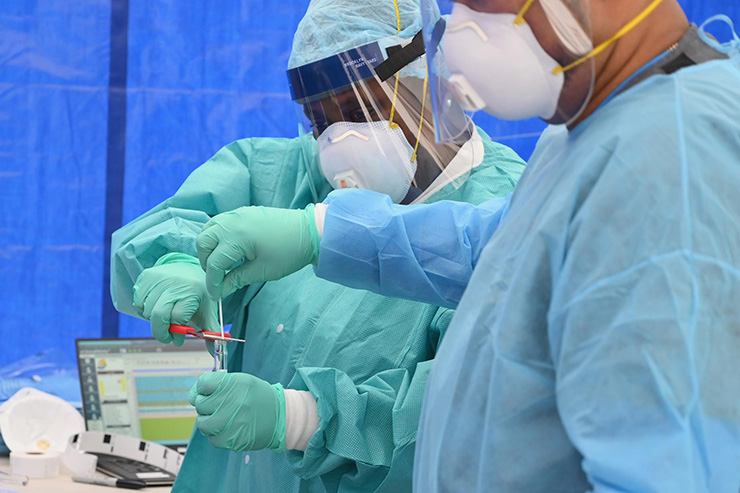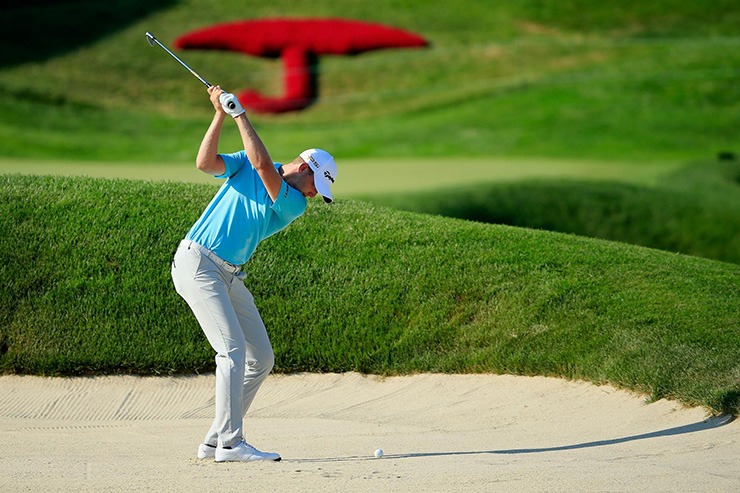By Joel Beall
The worry came to fruition in Hilton Head Friday, a PGA Tour player testing positive for COVID-19 during tournament play, forcing his withdrawal from the event. In itself, the news was not a shock; the tour planned for this. It had to: With 300-odd players and caddies competing in a given week, it was bound to happen. But when it happened, a mere 12 days and two tournaments into the tour’s return, and how it happened, with Nick Watney at the course as he was awaiting his results, have brought attention to a plan already under heightened observation.
As of Sunday’s conclusion of the RBC Heritage, Watney remains the only PGA Tour player to test positive, with 11 people who came in contact with Watney testing negative on Saturday after follow-up COVID-19 evaluations (more on this in a moment). Alarming times as these may be, anyone claiming Watney’s positive test is a catastrophe is, inadvertently or not, a prisoner of fear-mongering. Still while the overriding question remains the same—Can the tour pull this off?—another now precedes it:
After a positive test, where does the tour go from here?
It is not a query that begets a singular, clear-cut answer. However, after speaking with tour and tournament officials, players, caddies and an epidemiologist, the response also is not as ambiguous as it may seem.
Is golf still considered a safe sport?
A positive test at a tournament requires every facet of the tour’s effort to be re-evaluated, starting with the fundamental safety of playing golf. According to Dr. Amesh Adalja, a senior scholar at Johns Hopkins University’s Center for Health Security, that answer remains yes.
“It is very, very unlikely [Watney catching COVID-19] happened at the golf course,” said Dr. Adalja. “We continue to find out more about this virus every day, but we know outdoor transmission is much less likely than other activities.”
The low probability factors in the occasional breach of social distancing, like players and caddies touching clubs and groups congregating at the practice green. This is not to imply the virus can’t be passed while at the golf course, Dr. Adalja said. Just that the meaningful detective work should begin with where else Watney’s been, and who he was with.
“This is about contact tracing, that is the key,” Dr. Adalja said.

Photo by Ben Jared
Watney, who is now in self-isolation as required by the tour’s safety protocol for at least 10 days pending follow-up tests, has not commented publicly about his positive test or his whereabouts in the days prior, but Sergio Garcia confirmed he gave Watney a ride on his private plane from Texas (they both live in Austin) to South Carolina. Garcia has not tested positive thus far, but that transportation does raise its own point …
Does the tour need to rethink its bubble?
Well, the tour never had a “bubble,” per se. Travelling across the country, rather than picking a de facto home base for operations (like the NBA is doing with Disney World) shattered that notion. Chartered planes are convenient and safe options—players and caddies can only ride following a negative test—yet players and caddies are also making separate air, be it commercial or private, and ground arrangements. While there are designated host hotels, players are allowed to stay elsewhere. Despite the low odds of outside transmission and stringent policing on tournament grounds, the tour’s ecosystem begins and ends at the golf course. Outside those confines, it’s essentially the honour system meets the real world.
In that vein, there’s also the significance of where the tournaments are held. South Carolina and Texas are two current coronavirus hotspots in the United States, and as Justin Thomas noted on Saturday, Hilton Head seemed to be proceeding as if the pandemic was over. As of Sunday, 22 states were experiencing 14-day increases in cases, and the country’s new daily cases on Friday and Saturday breached 30,000, the most in six weeks. (Daily deaths are continuing to slowly decline.)
Now, any direct correlation to the island’s laissez-faire attitude and Watney’s test is a false equivalency. But Thomas’ remarks underscore how little of this is under tour jurisdiction, and control. And that truth is perhaps the toughest swallow, and biggest obstacle, going forward.
“There’s active community spread. Athletes are not immune,” Dr. Adalja said. “These bubbles are not hermetically sealed, and as we said, in the PGA Tour’s case, there is no bubble.”
Still, Watney’s positive has not triggered a massive revamping of the health and safety plan from the tour.
Sources with close knowledge of the subject tell Golf Digest that, while the tour will continue to improve and refine its protocols, it remains confident in the guidelines set forth. Likewise, sources with the Travelers Championship, next on the tour’s schedule, said the tournament is not deviating from its blueprint due to Watney’s test.
There will likely be an update sent to tour constituents on Monday or Tuesday, according to sources, but it will mostly be a reminder of the protocols and the need to maintain social-distancing practices. For now, the plan remains the same.
RELATED: 5 takeaways from the final round at Harbour Town
Do players and caddies trust the safety protocols?

Photo by Kevin C. Cox
Players are not shy when it comes to airing their grievances with the tour and its brass. But publicly and privately, Watney’s positive test has not appeared to have shaken the players’ faith in the tour’s system.
“I feel very safe. I wouldn’t be playing if I didn’t,” Thomas said Saturday. “The tour has done all the protocols they can.”
Thomas was joined by two other megastars in Rory McIlroy and Brooks Koepka, both maintaining their endorsements.
“Yeah, when I do the things I’m supposed to do and I’m at the tournament site, I feel very safe, yeah,” McIlroy said. Added Koepka: “We’re doing what we can as far as players, the tour—everybody’s doing what they can to make it safe for us, for everybody.”
Not to say the players are oblivious to what’s at hand. Webb Simpson, the eventual winner on Sunday at Harbour Town, went so far as calling the first positive test as a wake-up call of sorts.
“Yeah, it definitely got me thinking about kind of everything that I’ve done this week,” Simpson said. “I’ve tried to be really careful, but I could probably be more careful. I hadn’t really gone out to dinner. I’ve gotten takeout every night. But in terms of even wearing the mask, any time I’m out of my comfort zone away from the golf course, I think it’s smart.
“And really, the six-foot rule I’ve been good about, but I probably could be better.”
Overall though, the players are sticking with the company line. Golf Digest polled more than 20 players and caddies following news of Watney’s test and subsequent WD. Only a handful wavered in their confidence with the measures in place.
“If we didn’t have a positive test, I’m sure [the media] would have said we were hiding something,” a veteran player told Golf Digest. “If you look at how many people we tested, and the number of times we’ve been tested, I think [the positive test] indicates we are doing it right.”
This belief, one championed by multiple players, is not necessarily wrong. The PGA Tour conducted nearly 1,600 tests for golf’s return at the Charles Schwab Challenge in Fort Worth and the Korn Ferry Challenge at tour headquarters in Ponte Vedra Beach, with nearly 900 tests coming at tournament sites. In Week 1, only one Korn Ferry Tour player and three KFT caddies tested positive, all through home results. More than 770 tests were administered this week combined on both tours prior to tournament play, with two KFT caddies testing positive.
“This [positive test] isn’t a knock,” another tour player said. “We have done our part in staying vigilant.”
A quarter of respondents were perplexed why Watney was at the course, or why the tour let Watney come to the course with a pending test. Conversely, Watney’s well-being was their chief concern, none blaming him for his result. How the positive result came to be is a different matter.
Is there a flaw in the tour’s monitoring?

Photo by Angela Weiss
Again, Watney has not publicly spoken on his positive test, but according to McIlroy, it was a fitness tracker that notified Watney his respiratory rates were up, a possible sign of a COVID-19 infection. A source close to Watney confirmed to Golf Digest that the tracker’s data is what prompted a new test.
This is problematic, as Watney had tested negative earlier in the week and under the tour’s guidelines wouldn’t have been tested again until he provided a sample for the chartered flight (which he didn’t use when traveling from Colonial to Harbour Town). One can drive themselves mad with theoreticals, but without the fitness tracker, Watney could have gone along unfettered until taking his arrival test upon getting to the Travelers earlier this coming week.
Also of possible issue are the measures enacted by the positive test.
Upon the announcement of Watney’s result, the tour announced, “For the health and well-being of all associated with the tournament and those within the community, the tour has begun implementing its response plan in consultation with medical experts including working with those who may have had close contact with Nick.” The tour later confirmed that 11 tests were conducted on Friday to those who were around Watney, “with all 11 tests being negative,” a tour spokesperson told Golf Digest on Saturday.
However, preliminary research shows that if someone is tested too early, one day after potential exposure, their viral load may be below the threshold of detection, rendering a negative result.
“You wouldn’t detect someone being positive from exposure that quickly,” Dr. Adalja said. “We often wait several days. We monitor them, even those who are asymptomatic. Testing the day of, even a day after, contact would not show a positive test.”
It begs to ask, even with nearly 2,400 coronavirus tests administered, are more needed for proper surveillance? (Of course, the upshot: Wait too long, and the viral load may also be too low to register.)
There there’s the monitoring of those who have come in contact with Watney. Dr. Adalja says, ideally, anyone who came in contact with Watney would want to isolate for 14 days. Clearly that didn’t happen: Vaughn Taylor, one of Watney’s Thursday playing partners, made the cut and played on the weekend.
“Ideally” is the operative word above. Safety is of paramount importance; in that same breath, is it fair to make someone withdraw from at least two events because they “might” have caught the virus, especially if they ultimately don’t have COVID-19?
“I understand they believe they are keeping with protocols, but one break from the safety protocols can undo them all,” Dr. Adalja says.
Though tour officials maintain this does not change their thinking regarding testing for the upcoming week, they did not rule out additional safeguards being implemented. Expect one area to be addressed: How to prevent a scenario like Watney’s—where a player who is awaiting results is at the course—from happening again.
“We will do what we have to in order for us to safely conduct a tournament and to make sure our players feel safe doing so,” an official told Golf Digest.
What constitutes a critical mass?

As the PGA Tour moves on to Cromwell, Conn., for the Travelers Championship, the hope is that players and caddies protect themselves from the spread of the virus. (Photo by Michael Cohen)
This has been one of the primary questions left unanswered since the tour’s original announcement of its health and safety protocols. As this weekend proved, a single positive test does not suspend a tournament. During a May conference call on the protocols, Andy Levinson, senior vice president of tournament administration, said there’s not a specific number of positive tests the tour has in mind that would enact a cancellation.
“You know, when there is a positive test, there does have to be some contact tracing that takes place, which is why social distancing is … one of the many reasons why social distancing is so important,” Levinson said. “And so we haven’t identified a specific number, but obviously if it was a large number then we would have to evaluate the situation.”
Tour sources tell Golf Digest Levinson’s words remain true.
“There is not a touchstone for when we are going to say ‘That’s that,’” a tour official said. “There is a scenario where the number is low but we feel the environment has changed to the point we can’t safely host players, volunteers, broadcast partners. But we don’t see that [at Hilton Head] and are hearing positive reports from our Travelers Championship team.”
If there’s a main takeaway from Watney’s positive test, it’s that the tour is preaching calm, the players remain committed, the courses are safe. Yet the critical-mass question will likely become the question in the upcoming weeks. There is a chance Watney is an isolated case, but there is mounting evidence to suggest otherwise.
“This is just going to be the deal with someone all the time with professional sports. You saw it the past few days with MLB, NCAA outbreaks,” Dr. Adalja said. “This is something that is going to be the norm.”
The tour proclaimed a successful first step on its tightrope walk at Colonial. The show goes on to TPC River Highlands, and hopefully to Detroit and Columbus. But it’s fair to say the rope wobbled at Harbour Town.








